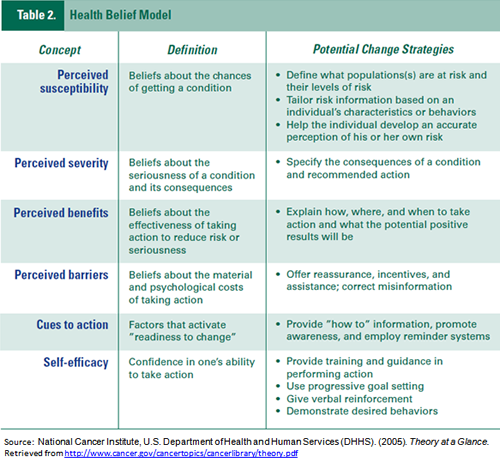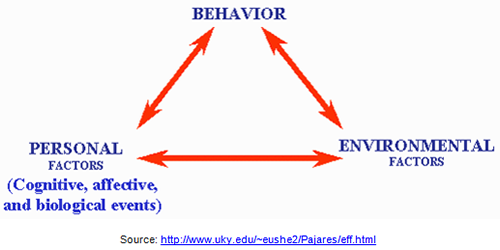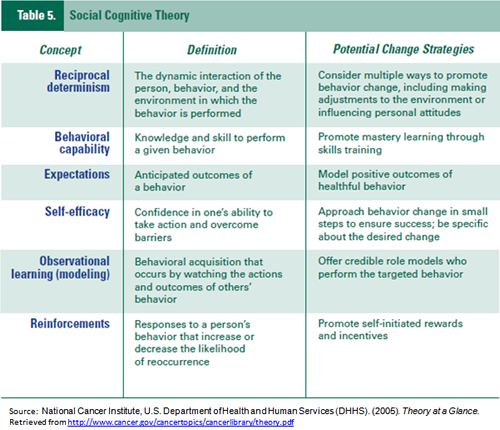Online Course
NRSG 780 - Health Promotion and Population Health
Module 9: Program Planning: Focus on Behavior Change
Individual and Interpersonal Level Behavior Change
On the individual and interpersonal level behavior change theories are categorized as “Cognitive-Behavioral” and focus on three key concepts:
- Knowledge affects action
- Knowledge is necessary but not sufficient to produce behavior change
- Perceptions, motivations, skills and the social environment are critical factors that influences behavior
This topic will highlight three behavior change models:
- Health Belief Model (HBM)
- Stages of Change (Transtheoretical) Model
- Social Cognitive Theory
There are many others that may assist you in program planning; and several additional models are discussed in the Theory at a Glance assigned reading.
Health Belief Model
The Health Belief Model focuses on an individual’s perceptions of the threat of a health problem and the behavior change necessary to prevent or manage the problem. It was developed by Godfrey Hochbaum, Stephen Kegels, and Irwin Rosenstock in the 1950s and is regarded as the beginning of systematic theory-based research in health behavior. It remains one of the most recognized models in the field.
It includes six factors that influence decisions and an individual’s readiness to act:
- Perceived susceptibility
- Perceived severity
- Perceived benefits
- Perceived barriers
- Cues to action
- Self-efficacy


Because the Health Belief Model focuses on the of the threat of susceptibility, it is important to recognize that it is not appropriate for developing programs for all age groups. This is particularly the case when designing programs for adolescents, who often perceive themselves as invulnerable. It is very effective with many other populations when trying to reduce the threat of disease.
The following image is an example of a health promotion program focusing on the "threat of susceptibility”.

Stages of Change (Transtheoretical) Model
The Stages of Change (Transtheoretical) Model is based on the premise that behavior change is a process, not an event. As individuals attempt to change behavior, they move through five stages:
- Precontemplation
- Contemplation
- Preparation
- Action
- Maintenance

Individuals can cycle back and forward in the process. The Stages of Change (Transtheoretical) Model It was developed by John Prochaska and Carlo DiClemente in 1983, and used to explain experiences of smokers trying to quit.

This model has been used successfully in a variety of settings, and continues to be used to understand and examine health behaviors such as smoking, substance abuse, exercise and dietary behaviors. Dr. DiClemente is on the faculty of UMBC and leads its HABITS Laboratory.
Social Cognitive Theory (SCT)
Social Cognitive Theory focuses on the dynamic interrelationships of personal factors, environmental factors and human behavior. It was developed by Albert Bandura in 1986, and identifies three main factors that influence health behavior:
- Self-efficacy--Individual’s beliefs about their capabilities to produce designated levels of performance that exercise influence over events that affect their lives
- Goals
- Outcome expectancies
Social Cognitive Theory’s critical element is self-efficacy. Factors effecting self-efficacy include:
- Affective Processes: Processes regulating emotional states and elicitation of emotional reactions
- Cognitive Processes: Thinking processes involved in the acquisition, organization and use of information
- Motivation: Activation to action--level of motivation is reflected in choice of courses of action, and in the intensity and persistence of effort
- Self-Regulation: Exercise of influence over one's own motivation, thought processes, emotional states and patterns of behavior

Bandura supported the view that individual actions are the result of an interaction among personal, behavioral and environmental influences. Individuals consider the results of their own behavior, personal factors, and alter their environment to change subsequent behavior. Bandura changed the label of his theory from social learning to social “cognitive theory” to emphasize the role that cognition plays in “people’s capability to construct reality, self-regulate, encode information, and perform behaviors” (para 2).
Source: Pajares, F. (2002).Overview of social cognitive theory and of self-efficacy. Retrieved from http://www.uky.edu/~eushe2/Pajares/eff.html


Social Cognitive Theory has been used successfully in changing behavior in a number of domains including dietary behavior, HIV/AIDs, breastfeeding and pain control. One of the most well recognized is the Stanford Chronic Disease Self-Management Program developed by Kate Lorig, DrPH, RN.
For more information on the application of behavior models in community health promotion programs read Kreuter, M., Lezin, N.,Kreuter, M., Green, L. Community health promotion Ideas that work Chapter 5: Theory applied, Sudbury, MA: Jones and Bartlett. Available through HS/HSL Course Reserves in 780 blackboard.
This website is maintained by the University of Maryland School of Nursing (UMSON) Office of Learning Technologies. The UMSON logo and all other contents of this website are the sole property of UMSON and may not be used for any purpose without prior written consent. Links to other websites do not constitute or imply an endorsement of those sites, their content, or their products and services. Please send comments, corrections, and link improvements to nrsonline@umaryland.edu.